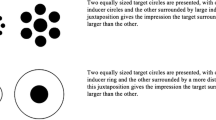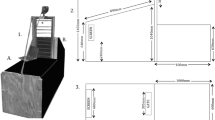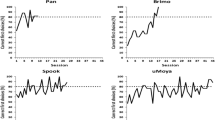Abstract
In the last decade, visual illusions have been repeatedly used as a tool to compare visual perception among species. Several studies have investigated whether non-human primates perceive visual illusions in a human-like fashion, but little attention has been paid to other mammals, and sensitivity to visual illusions has been never investigated in the dog. Here, we studied whether domestic dogs perceive the Delboeuf illusion. In human and non-human primates, this illusion creates a misperception of item size as a function of its surrounding context. To examine this effect in dogs, we adapted the spontaneous preference paradigm recently used with chimpanzees. Subjects were presented with two plates containing food. In control trials, two different amounts of food were presented in two identical plates. In this circumstance, dogs were expected to select the larger amount. In test trials, equal food portion sizes were presented in two plates differing in size: if dogs perceived the illusion as primates do, they were expected to select the amount of food presented in the smaller plate. Dogs significantly discriminated the two alternatives in control trials, whereas their performance did not differ from chance in test trials with the illusory pattern. The fact that dogs do not seem to be susceptible to the Delboeuf illusion suggests a potential discontinuity in the perceptual biases affecting size judgments between primates and dogs.



Similar content being viewed by others
References
Agrillo C, Piffer L, Bisazza A (2011) Number versus continuous quantity in numerosity judgments by fish. Cognition 119:281–287
Agrillo C, Miletto Petrazzini ME, Tagliapietra C, Bisazza A (2012) Inter-specific differences in numerical abilities among teleost fish. Front Psychol 3:483
Agrillo C, Piffer L, Adriano A (2013) Individual differences in non-symbolic numerical estimation predict mathematical abilities but contradict ATOM. Behav Brain Funct 9:26
Agrillo C, Parrish AE, Beran MJ (2014a) Do rhesus monkeys (Macaca mulatta) perceive the Zöllner illusion? Psychon Bull Rev 21(4):986–994
Agrillo C, Parrish AE, Beran MJ (2014b) Do primates see the solitaire illusion differently? A comparative assessment of humans (Homo sapiens), chimpanzees (Pan troglodytes), rhesus mon- keys (Macaca mulatta), and capuchin monkeys (Cebus apella). J Comp Psychol 128(4):402–413
Agrillo C, Gori S, Beran MJ (2015) Do rhesus monkeys (Macaca mulatta) perceive illusory motion? Anim Cogn 18:895–910
Baker JM, Morath J, Rodzon KS, Jordan KE (2012) A shared system of representation governing quantity discrimination in canids. Front Psych 3:387
Bánszegi O, Urrutia A, Szenczi P, Hudson R (2016) More or less: spontaneous quantity discrimination in the domestic cat. Anim Cogn 19(5):879–888
Benhar E, Samuel D (1982) Visual illusions in the baboon (Papio anibis). Anim Learn Behav 10:115–118
Brannon EM, Lutz D, Cordes S (2006) The development of area discrimination and its implications for number representation in infancy. Dev Sci 9:F59–F64
Bravo M, Blake R, Morrison S (1988) Cats see subjective contours. Vis Res 28:861–865
Byosiere SE, Feng LC, Woodhead JK, Rutter NJ, Chouinard PA, Howell TJ, Bennett PC (2016) Visual perception in domestic dogs: susceptibility to the Ebbinghaus– Titchener and Delboeuf illusions. Anim Cogn. doi:10.1007/s10071-016-1067-1
Davis B, Payne CR, Bui M (2016) Making small food units seem regular: how larger table size reduces calories to be consumed. J Ass Consum Res 1(1):115–124
Dominy NJ, Lucas PW (2001) Ecological importance of trichromatic vision to primates. Nature 410:363–366
Fagnani J, Barrera G, Carballo F, Bentosela M (2016) Is previous experience important for inhibitory control? A comparison between shelter and pet dogs in A-not-B and cylinder tasks. Anim Cogn 19:1165–1172
Fujita K, Matsuzawa T (1990) Delayed figure reconstruction by a chimpanzee (Pan troglodytes) and humans (Homo sapiens). J Comp Psychol 104:345–351
Guo K, Meints K, Hall C, Hall S, Mills D (2009) Left gaze bias in humans, rhesus monkeys and domestic dogs. Anim Cogn 12:409–418
Hopkins WD (1997) Hemispheric specialization for local and global processing of hierarchical visual stimuli in chimpanzees (Pan troglodytes). Neuropsychologia 35:343–348
Hopkins WD, Washburn DA (2002) Matching visual stimuli on the basis of global and local features by chimpanzees (Pan troglodytes) and rhesus monkeys (Macaca mulatta). Anim Cogn 5:27–31
Horowitz A, Hecht J, Dedrick A (2013) Smelling more or less: investigating the olfactory experience of the domestic dog. Learn Motiv 44(4):207–217
Hunt S, Low J, Burns K (2008) Adaptive numerical competency in a food-hoarding songbird. Proc R Soc Lond B 275:2373–2379
Kanizsa G, Renzi P, Conte S, Compostela C, Guerani L (1993) Amodal completion in mouse vision. Perception 22:713–721
Kelley LA, Endler JA (2012) Illusions promote mating success in great bowerbirds. Science 335:335–338
Kelley LA, Kelley JL (2014) Animal visual illusion and confusion: the importance of a perceptual perspective. Behav Ecol 25:450–463
Kimchi R (1992) Primacy of wholistic processing and global/local paradigm: a critical review. Psychol Bull 112:24–38
Kwok RM, Braddick OJ (2003) When does the Titchener Circles illusion exert an effect on grasping? Two- and three-dimensional targets. Neuropsychologia 41:932–940
Lakens D (2013) Calculating and reporting effect sizes to facilitate cumulative science: a practical primer for t-tests and ANOVAs. Front Psychol 4:863
Lamb TD, Collin SP, Pugh EN Jr (2007) Evolution of the vertebrate eye: opsins, photoreceptors, retina and eye cup. Nat Rev Neurosci 8:960–976
Lucon-Xiccato T, Miletto Petrazzini ME, Agrillo C, Bisazza A (2015) Guppies discriminate between two quantities of food items but prioritize item size over total amount. Anim Behav 107:183–191
Masland RH, Martin PR (2007) The unsolved mystery of vision. Curr Biol 17:R577–R582
Miletto Petrazzini ME, Wynne CD (2016) What counts for dogs (Canis lupus familiaris) in a quantity discrimination task? Behav Proc 122:90–97
Navon D (1977) Forest before trees: the precedence of global features in visual perception. Cogn Psych 9:353–383
Neitz J, Geist T, Jacobs G (1989) Color vision in the dog. Visual Neurosci 3:119–125
Parrish AE, Beran MJ (2014) When less is more: like humans, chimpanzees (Pan troglodytes) misperceive food amounts based on plate size. Anim Cogn 17:427–434
Parrish AE, Agrillo C, Perdue B, Beran MJ (2016) The elusive illusion: do children (Homo sapiens) and capuchin monkeys (Cebus apella) see the solitaire illusion? J Child Exp Psychol 142:83–95
Piffer L, Miletto Petrazzini ME, Agrillo C (2013) Large number discrimination in newborn fish. PLoS ONE 8(4):e62466
Pitteri E, Mongillo P, Carnier P, Marinelli L (2014) Hierarchical stimulus processing by dogs. Anim Cogn 17:869–877
Racca A, Amadei E, Ligout S, Guo K, Meints K, Mills D (2010) Discrimination of human and dog faces and inversion responses in domestic dogs (Canis familiaris). Anim Cogn 13:525–533
Range F, Aust U, Steurer M, Huber L (2008) Visual categorization of natural stimuli by domestic dogs. Anim Cogn 11(2):339–347
Range F, Jenikejew J, Schröder I, Virányi Z (2014) Difference in quantity discrimination in dogs and wolves. Front Psychol 5:1299
Rose D, Bressan P (2002) Going round in circles: shape effects in the Ebbinghaus illusion. Spat Vis 15:191–203
Stancher G, Rugani R, Regolin L, Vallortigara G (2015) Numerical discrimination by frogs (Bombina orientalis). Anim Cogn 18:219–229
Suganuma E, Pessoa VF, Monge-Fuentes V, Castro BM, Tavares MCH (2007) Perception of the Müller-Lyer illusion in capuchin monkeys (Cebus apella). Behav Brain Res 182:67–72
Udell MAR, Dorey NR, Wynne CDL (2008) Wolves outperform dogs in following human social cues. Anim Behav 76:1767–1773
Uller C, Jaeger R, Guidry G, Martin C (2003) Salamanders (Plethodon cinereus) go for more: rudiments of number in an amphibian. Anim Cogn 6(2):105–112
Van Ittersum K, Wansink B (2007) Do children really prefer large portions? Visual illusions bias their estimates and intake. J Am Diet Assoc 107:1107–1110
Wansink B, Painter JE, North J (2005) Bottomless bowls: why visual cues of portion size may influence intake. Obes Res 13:93–100
Ward C, Smuts BB (2007) Quantity-based judgments in the domestic dog (Canis lupus familiaris). Anim Cogn 10:71–80
West RE, Young RJ (2002) Do domestic dogs show any evidence of being able to count? Anim Cogn 5:183–186
Acknowledgements
The authors would like to thank Anansi Cappellato for her help in testing the subjects. The study complies with all laws of the country (Italy) in which it was performed and was supported by “FIRB Grant 2013” (prot.: RBFR13KHFS) to C. Agrillo and by “PRIN Grant 2015” (prot.: 2015FFATB7) to A. Bisazza from Ministero dell’Istruzione, Università e Ricerca (MIUR, Italy). We also thank Sarah-Elizabeth Byosiere and her co-authors for sharing the results of Byosiere et al. (2016) prior to publication.
Author information
Authors and Affiliations
Corresponding author
Rights and permissions
About this article
Cite this article
Miletto Petrazzini, M.E., Bisazza, A. & Agrillo, C. Do domestic dogs (Canis lupus familiaris) perceive the Delboeuf illusion?. Anim Cogn 20, 427–434 (2017). https://doi.org/10.1007/s10071-016-1066-2
Received:
Revised:
Accepted:
Published:
Issue Date:
DOI: https://doi.org/10.1007/s10071-016-1066-2




